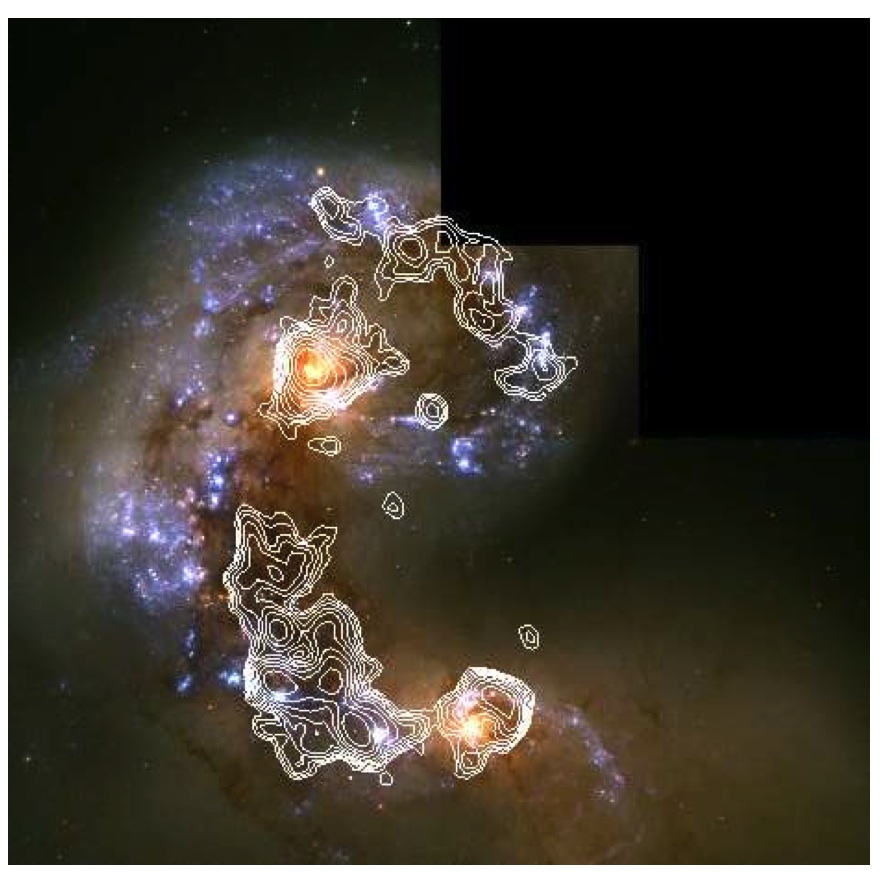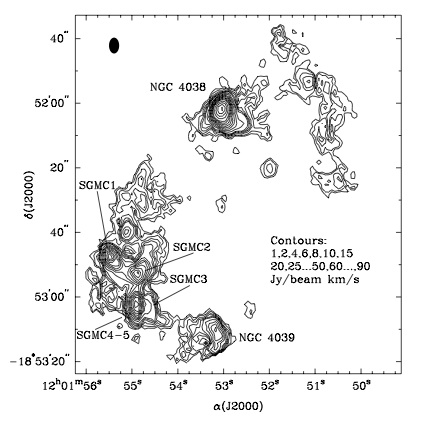AntennaeBand7 for CASA 3.3
Draft casaguide for the Antennae at Band 7
Science Target Overview


The Antennae galaxy is a colliding galaxy pair located at a distance of 22 Mpc in the southern sky. Their coordinates are (12h 01m, -18° 30') and ideally suited for a long integration at the ALMA site.
The molecular properties of Antennae have been studied with high resolution by Wilson et al. (2000), who conducted the CO(1-0) observations using the OVRO.
We acknowledge Junko Ueda for suggesting Antennae for ALMA Science Verification...
ALMA Data Overview
ALMA Science verification data on Antennae galaxies in Band 7 were taken in nine different datasets over several nights in May and June 2011, in order to get good uv-coverage. The datasets are listed next, classified as observations for the northern -NGC4038- and southern components -NGC4039- of Antennae.
B7 north
- uid://A002/X1ff7b0/Xb
- uid://A002/X207fe4/X3a
- uid://A002/X207fe4/X3b9
- uid://A002/X2181fb/X49
B7 south
- uid://A002/X1ff7b0/X1c8
- uid://A002/X207fe4/X1f7
- uid://A002/X207fe4/X4d7
- uid://A002/X215db8/X1d5
- uid://A002/X215db8/X392
- uid://A002/X215db8/X18
These Band 7 observations utilized two basebands, which are associated with two different spectral windows: one in the Upper Sideband (USB) and one in the Lower Sideband (LSB). The first spectral window is centered on the CO(3-2) emission line in the galaxy Antenna. The additional spectral window in the USB is used to measure the continuum emission in the galaxy and may contain other emission lines as well. Each spectral window has a total bandwidth of 2 GHz divided over 3840 channels (FDM mode), for a channel width of 488.28 MHz, corresponding to 1634 km/s and 0.426 km/s respectively. For the antenna configuration that was used during these observations, the angular resolution is expected to be about 1".
Obtaining the Data
To download the data, click on the region closest to your location:
Here you will find three gzipped tar files which, after unpacking, will create three directories:
- Antennae_Band7_UnCalibratedMSandTablesForReduction - Here we provide you with "starter" datasets, where we have taken the raw data in ALMA Science Data Model (ASDM) format and converted them to CASA Measurement Sets (MS). We did this using the importasdm task in CASA. Along with the raw data, we also provide some tables that you will need for the calibration which cannot currently be generated inside of CASA. (This functionality will be available in CASA for Early Science.)
- Antennae_Band7_CalibratedData - The fully-calibrated uvdata, ready for imaging and self-calibration
- Antennae_Band7_ReferenceImages - The final continuum and spectral line images
To see which files you will need, read on below. The downloads to your local computer will take some time, so you may wish to begin them now.
NOTE: CASA 3.2.1 or later is required to follow this guide. For more information on obtaining the latest version of CASA, see http://casa.nrao.edu.
Antennae Band 7 Data Reduction Tutorial
In this tutorial, or "casaguide", we will guide you step-by-step through the reduction of the ALMA science verification data on the Antennae galaxies and its subsequent imaging. This casaguide consists of two parts:
1) Antennae Band7 - Calibration
To complete the Calibration section of the tutorial, you will need the data in the first directory: Antennae_Band7_UnCalibratedMSandTablesForReduction. For those wishing to skip the calibration section and proceed to Imaging, we also provide the fully-calibrated data in the Antennae_Band7_CalibratedData directory. Finally, we provide the final continuum and spectral line images in the Antennae_Band7_ReferenceImages directory.
For a similar tutorial on the reduction of ALMA Band 7 data on TW Hydra, and Band 3 on NGC 3256, see the casaguide TWHydraBand7 and NGC3256Band3.
How to use this casaguide
For both portions of the guide, we will provide you with the full CASA commands needed to carry out each step.
# In CASA
The commands you need to execute
will be displayed in regions
like this.
Simply copy and paste the commands in order into your CASA terminal. You may also type the commands in by hand if desired, but be mindful of typos. Note that you may need to hit Enter twice in order for the process to start running. Also note that copying and pasting multiple commands at a time may not work, so only copy and paste the contents of one region at a time.
To learn how to extract the CASA commands into an executable python script, click here.
Occasionally we will also show output to the CASA logger:
This output will be displayed in regions like this.
For a brief introduction to the different ways CASA can be run, see the EVLA_Spectral_Line_Calibration_IRC+10216#How_to_Use_This_casaguide page. For further help getting started with CASA, see Getting_Started_in_CASA.
Daniel Espada 12:00 UT, 21 July 2011